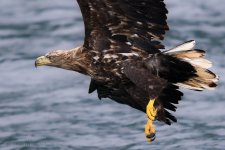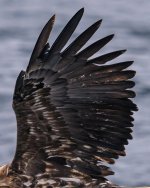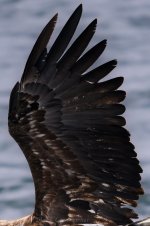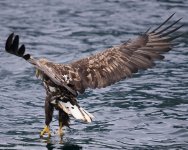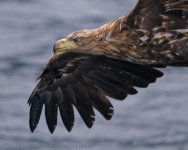-
Welcome to BirdForum, the internet's largest birding community with thousands of members from all over the world. The forums are dedicated to wild birds, birding, binoculars and equipment and all that goes with it.
Please register for an account to take part in the discussions in the forum, post your pictures in the gallery and more.
You are using an out of date browser. It may not display this or other websites correctly.
You should upgrade or use an alternative browser.
You should upgrade or use an alternative browser.
What age is this White tailed eagle? Norway (1 Viewer)
- Thread starter Ratatoskr
- Start date
More options
Who Replied?Alexander Stöhr
Well-known member
Hello Mats,
what an impresive close up portrait of this huge bird! Tfs!
With the cautious words in an older paper from the german journal Limicola I skipped ageing of subadult White tailed Eagles, leaving only 3 classes that I feel I can do (juvenile, immature and adult).
The only thing that came into my mind is that your bird has still a quite dark orange iris, while adult WTE have starringly pale eyes, regular obvious at a distance.
So like you I hope for more comments. Thanks!
Here is the excellent paper (roughly at least the same version): https://www.zobodat.at/pdf/DENISIA_0027_0159-0171.pdf
what an impresive close up portrait of this huge bird! Tfs!
With the cautious words in an older paper from the german journal Limicola I skipped ageing of subadult White tailed Eagles, leaving only 3 classes that I feel I can do (juvenile, immature and adult).
The only thing that came into my mind is that your bird has still a quite dark orange iris, while adult WTE have starringly pale eyes, regular obvious at a distance.
So like you I hope for more comments. Thanks!
Here is the excellent paper (roughly at least the same version): https://www.zobodat.at/pdf/DENISIA_0027_0159-0171.pdf
Ratatoskr
Systems Engineer - Greenpeace
Thank youHello Mats,
what an impresive close up portrait of this huge bird! Tfs!
With the cautious words in an older paper from the german journal Limicola I skipped ageing of subadult White tailed Eagles, leaving only 3 classes that I feel I can do (juvenile, immature and adult).
The only thing that came into my mind is that your bird has still a quite dark orange iris, while adult WTE have starringly pale eyes, regular obvious at a distance.
So like you I hope for more comments. Thanks!
Here is the excellent paper (roughly at least the same version): https://www.zobodat.at/pdf/DENISIA_0027_0159-0171.pdf
and thanks for the paper too, it will go into my guides folder.
Those eye markers and others like the wear of feathers are things I need to learn a lot more about.

Hi Mats
great pic indeed!
According to Dick Forsman FLIGHT IDENTIFICATION this should be an early third plumage (3rd CY spring): base of bill and brown iris both turn lighter. Also at least 2 juvenile secondaries visible (if you have shots of the primaries, it would be interesting to look for faded juvenile outer primaries), northern birds should have one or two juvenile outer primaries. Central European birds may be much more advanced.
great pic indeed!
According to Dick Forsman FLIGHT IDENTIFICATION this should be an early third plumage (3rd CY spring): base of bill and brown iris both turn lighter. Also at least 2 juvenile secondaries visible (if you have shots of the primaries, it would be interesting to look for faded juvenile outer primaries), northern birds should have one or two juvenile outer primaries. Central European birds may be much more advanced.
That seems (to me) ambiguous, so... just checking (I've only got his Field Identification, though his classification seems to have been similar in that)... Presumably this should be: 3rd plumage (4th calendar year spring)? - though actually the date of the photo hasn't been given.According to Dick Forsman FLIGHT IDENTIFICATION this should be an early third plumage (3rd CY spring)

We desperately need the date, I agree, assumed recently.That seems (to me) ambiguous, so... just checking (I've only got his Field Identification, though his classification seems to have been similar in that)... Presumably this should be: 3rd plumage (4th calendar year spring)? - though actually the date of the photo hasn't been given.
Third plumage starts spring (when moult resume) 3 cy till spring 4 cy with huge individual and geographic variation. So both 3 cy and 4 cy (retarded) are possible. More details on how many juvenile secondaries and primaries left would be welcome too.
Imho best called 3rd plumage without cy due to bill colour, iris colour, retained juvenile secondaries and white speckling on body
Thanks for clarifying that - and for confirming that it's crucial to know the date of the photo.
Sounds like Forsman may have tweaked his classification between 1999 and 2016: formerly, his 2nd plumage ran up to 3rd calendar year spring, and 3rd plumage was stated to start in 3rd calendar year autumn. Hence my confusion. So, in summary (and making the assumption that the photo is recent - if not, everything changes), the bird is (late 2nd plumage? or) early 3rd plumage ( = 3rd calendar year spring)
Sounds like Forsman may have tweaked his classification between 1999 and 2016: formerly, his 2nd plumage ran up to 3rd calendar year spring, and 3rd plumage was stated to start in 3rd calendar year autumn. Hence my confusion. So, in summary (and making the assumption that the photo is recent - if not, everything changes), the bird is (late 2nd plumage? or) early 3rd plumage ( = 3rd calendar year spring)

Yes please, would be interesting to see unmoulted primariesIf needed, I have the whole left wing visible in the original photo. I may also have several other photos from other angles of this individual.
Ratatoskr
Systems Engineer - Greenpeace
Ratatoskr
Systems Engineer - Greenpeace
I will tomorrow see if I have any more good pic of the right wing. You want it from the top or bottom?Thanks, that confirms that we have one juvenile primary left (P9 growing) and 2 juvenile secondaries , third plumage. Strange things in the right wing though, last pic or other pics of right wing most welcome
What seems strange about the right wing?

Thanks, there seems more moult waves in the right wing, but maybe just play of shadowsI will tomorrow see if I have any more good pic of the right wing. You want it from the top or bottom?
What seems strange about the right wing?
Ratatoskr
Systems Engineer - Greenpeace
Here's more from the right wing, underside. Not the best photo, bit unsharp.
This is what I have from an accredited Norwegian specialist in eagles, on a Facebook group, had to say about this individual.
He received the same photos from above, not this latest photo.
Left wing shows P9 has been moulted this season and new one on the way while P10 is juvenile. Right wings P9 the same, new one on the way. He's questioning the P10 on right wing, seeming to be missing and wondering if it's just been released. S1 moulted this season and new one almost completely grown out. He goes on with other markers too and then goes on saying that it all indicates towards this individual being in final stages of moulting it's juvenile primaries, and that the standard procedure for Norwegian White tailed eagles is that the two outermost primaries are moulted in the fourth season for swing feather felling.
I'm not Norwegian so I'm not understanding those last words, swing feather felling (i fjerde sesong for svingfjærfelling). But I'm guess you guys can deduce what he means.
I don't know much about identifying bird in detail, so I may have translated some stuff incorrectly. I can always send you the whole Norwegian text.
He concludes saying that this "should" be a 5cy individual, and he says he's quite sure of this.
As far as I can understand what you guys are saying here, a lot of what he finds is the same as you guys had already concluded on, especially you Tom. Or am I completely in the blue?
But you seem to come to conclude differently on age?
This is what I have from an accredited Norwegian specialist in eagles, on a Facebook group, had to say about this individual.
He received the same photos from above, not this latest photo.
Left wing shows P9 has been moulted this season and new one on the way while P10 is juvenile. Right wings P9 the same, new one on the way. He's questioning the P10 on right wing, seeming to be missing and wondering if it's just been released. S1 moulted this season and new one almost completely grown out. He goes on with other markers too and then goes on saying that it all indicates towards this individual being in final stages of moulting it's juvenile primaries, and that the standard procedure for Norwegian White tailed eagles is that the two outermost primaries are moulted in the fourth season for swing feather felling.
I'm not Norwegian so I'm not understanding those last words, swing feather felling (i fjerde sesong for svingfjærfelling). But I'm guess you guys can deduce what he means.
I don't know much about identifying bird in detail, so I may have translated some stuff incorrectly. I can always send you the whole Norwegian text.
He concludes saying that this "should" be a 5cy individual, and he says he's quite sure of this.
As far as I can understand what you guys are saying here, a lot of what he finds is the same as you guys had already concluded on, especially you Tom. Or am I completely in the blue?
But you seem to come to conclude differently on age?
Attachments
Last edited:
Users who are viewing this thread
Total: 2 (members: 0, guests: 2)




